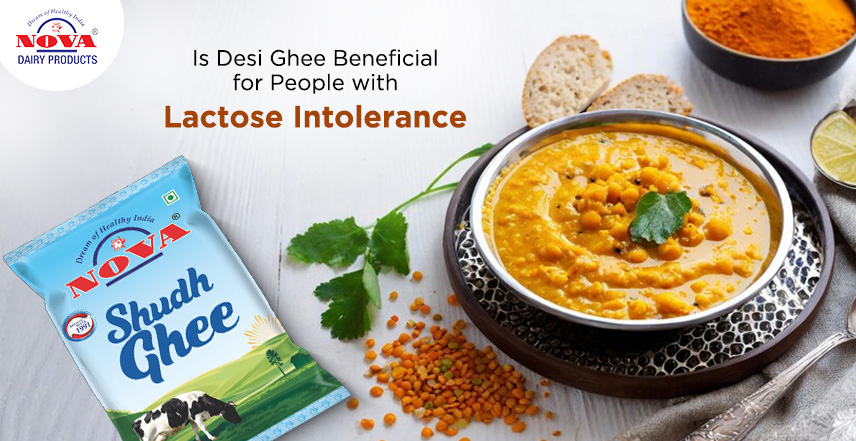If you or someone in your family has lactose intolerance, even a simple meal can feel like a minefield. Milk, butter, curd—what’s safe? What will cause discomfort? Amid all the dietary confusion, one ingredient has quietly remained a staple in Indian kitchens: desi ghee. But is it really safe for people who can’t tolerate dairy?
In this article, we’ll explore whether ghee fits into a lactose-free lifestyle, how it’s made, its digestive and nutritional benefits, and what to look for when buying ghee online. If you’ve been avoiding ghee out of fear, it’s time to find out whether pure desi ghee could actually be a game-changer for your diet.
What Is Lactose Intolerance?
Lactose intolerance is a common digestive issue that happens when your body doesn’t make enough lactase, the enzyme responsible for breaking down lactose. Lactose is the natural sugar found in milk and most dairy products.
Without enough lactase, the undigested lactose ferments in the gut, leading to uncomfortable symptoms like bloating, gas, cramps, or diarrhea soon after eating dairy. This condition is especially widespread in adults and is even more common across Asian populations, including India, where a large number of people are sensitive to milk-based foods.
Along with lactose, another dairy component that causes problems for some people is casein. It is the main protein in milk which gives it the white colour, and is also found in cheese, yogurt, and cream. It can be difficult to digest and may cause allergic reactions in sensitive individuals. Fortunately, traditional ghee-making removes most of the casein, making ghee a gentler option for those avoiding dairy proteins.
Recognising lactose intolerance is the first step in making smarter food choices that keep your gut happy without missing out on nourishment and flavor.
Is Desi Ghee Lactose-Free?
Yes, traditionally made shudh desi ghee is almost always lactose-free. It is prepared by slowly simmering butter until milk solids separate and settle. These solids contain most of the lactose and casein. Once they are removed, what remains is pure butterfat. This clear, golden liquid is ghee.
Because it no longer contains milk sugar or protein, pure desi ghee is usually well-tolerated by people who are lactose-intolerant. However, if your sensitivity is severe, it’s best to choose ghee made using traditional methods. Always read the label, especially when buying ghee online. Make sure it’s not mixed with milk solids, oils, or additives that could upset your stomach.
Why Desi Ghee Is Safer Than Butter or Milk
Here’s why ghee might be safer for you than butter or milk if you’re lactose intolerant:
- No Milk Solids : Most of the lactose and casein are removed during preparation.
- Rich in Butyrate : Supports gut lining health and reduces inflammation.
- Easier to Digest : Unlike milk or curd, ghee doesn’t require lactase for digestion.
- Stable Cooking Fat : Doesn’t break down easily when heated, making it great for Indian cooking.
Benefits of Desi Ghee for Lactose-Intolerant People
Here are some benefits of consuming desi ghee for people with lactose intolerance.
1. Gut-Friendly Fat
Ghee contains butyric acid, a short-chain fatty acid that helps nourish the gut lining and promotes smoother digestion.
2. Improves Nutrient Absorption
Fat-soluble vitamins like A, D, E, and K are better absorbed when consumed with ghee—important for those who avoid milk and may miss these nutrients.
3. Reduces Inflammation
Chronic inflammation is common in digestive disorders. The anti-inflammatory properties of desi ghee can help reduce symptoms.
4. Dairy Taste Without the Dairy
Ghee provides the richness of butter without the lactose, offering a safe and delicious alternative for cooking.
How to Use Ghee in a Dairy-Free Diet
If you’ve been avoiding dairy, here’s how you can start using ghee confidently:
- Use it to cook everyday meals like sabzis, dals, and curries
- Add a spoonful to steamed rice, khichdi, or millets for extra richness
- Use it for tadka to enhance the flavour of your dishes
- Swap butter with desi ghee for baking or cooking traditional sweets
Buying Ghee Online: What to Look For
Not all ghee is safe if you’re lactose-intolerant. Here’s how to pick the right one:
- Look for “pure desi ghee” or “shudh desi ghee” on the label
- Choose A2 or grass-fed varieties made using traditional methods
- Avoid ghee blends with added oils or milk fats
- Check for brand transparency: Look for brands that mention sourcing, methods, and lab testing
Any Risks to Watch Out For?
If you’re highly sensitive to even trace amounts of dairy, start with a small quantity and see how your body reacts. Most people with lactose intolerance have no problem digesting ghee, but everyone is different. When in doubt, choose ghee online from brands that guarantee high purity.
Final Thoughts
For those with lactose intolerance, desi ghee offers a rare win: the flavor and nourishment of dairy, without the discomfort. Its natural composition, digestibility, and nutrient profile make it a smart and safe addition to your daily meals.
Whether you use it to cook, season, or just enhance the taste of your food, choosing high-quality pure desi ghee or shudh desi ghee made traditionally ensures you get all the benefits with none of the worry.
So go ahead—reclaim your love for ghee, one spoonful at a time.

